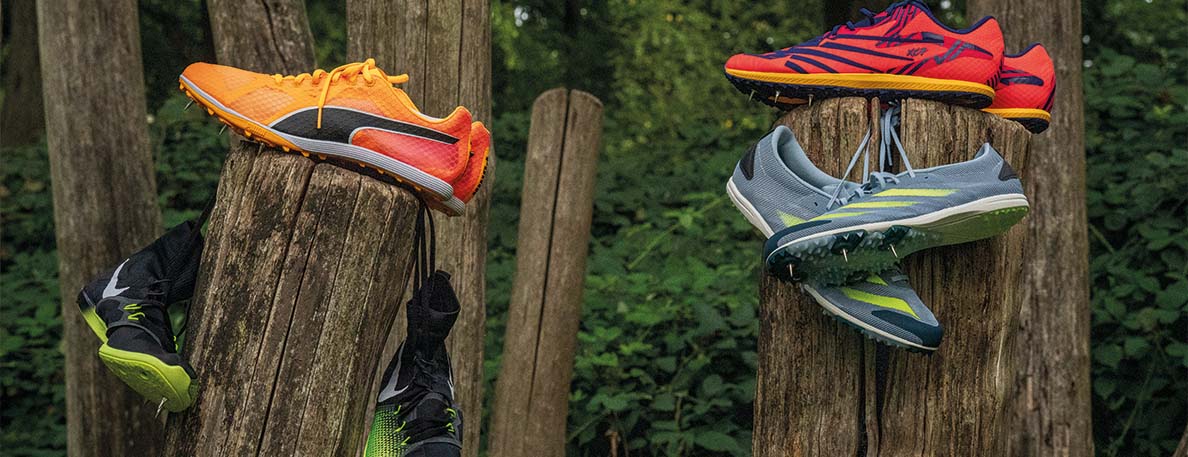How to choose the right spikes?
It all depends on your discipline, experience, and performance level. For the best advice, it's best to visit one of our Runners' lab stores. Our advisors know better than anyone else which spikes you need.
Moreover, you'll receive a free running analysis. Our stores are equipped with a running lane, allowing us to accurately identify your foot pattern to then recommend the right spike for you.
Do you prefer buying your spikes online? Then we'll at least set you on the right track.
Consider the following first:
- For which discipline do I use the spikes?
- How much experience do I have in the sport?
- At what level do I perform, and how often do I train?
Do you have specific questions about spikes? Take a look at our FAQs about spikes or send a message to our Live WhatsApp team.
1. Running spikes
CROSS
Do you enjoy crossing in the field? Then you need some cross-country running spikes.
Typical features:
- There is no spike plate underneath. The spikes should be flexible enough to push yourself through the mud.
- A stiffened plate - mostly made out of plastic - for the spike pins.
SPRINT
The short or sprint distance races on the track go up to 400 meters.
Typical features:
- Longer, mostly full-length, spike plate.
- Less cushioning. The spike weights preferably as less as possible, which means the amount of foam is limited. For shorter distances, you won't miss this cushioning.
MIDDLE AND LONG DISTANCE
The middle and long distance races on the track go from 800m.
Typical features:
- Shorter spike plate, mostly from toe to midfoot.
- More cushioning. Your feet must undergo pressure for a longer distance, so extra comfort is desirable for the comfort during running.
2. Jump spikes
HIGH JUMP
Typical features:
- a strap on top of the shoe keeps your midfoot secure, which is helpful for the push-off.
- There are extra pins in the heel for extra traction.
TRIPLE JUMP
Typical features:
- The heel is always shaped as a square. That creates extra stability when pushing of.
LONG JUMP
Typical features:
- These spikes are relatively stiff. You need that to make enough speed in your run-up.
- Compared to other spikes, like spint spikes, these long jump spikes are quite heavy. This robustness is needed for the landing.
POLE VAULT
Typical features:
- The plate underneath is mostly long. That gives extra propulsion and rebound when pushing of.
3. Throwing spikes
JAVELIN
Typical features:
- A higher ankle fit creates more stability.
- There are four pins in the heel for extra traction.
- A reinforced toe box: when throwing the javelin, you put the tip of your back feet sideways on the ground. The extra toe protection is therefore desirable.
- The strap on top of the midfoot keeps your foot secure in the shoes.
DISCUS THROW AND SHOT PUT
Typical features:
- For the elites who make the typical turn movement when throwing, the spikes has a smooth bottom for the spin technique.
- For more recreative athletes, who don't make this spin technique, the outsole has a textured rubber for better traction.
SHOT PUT
Typical features:
- For the elites who make the typical turn movement when throwing, the spikes has a smooth bottom for the spin technique.
- For more recreative athletes, who don't make this spin technique, the outsole has a textured rubber for better traction.
HAMMER THROW
Typical features:
- For the elites who make the typical turn movement when throwing, the spikes has a smooth bottom for the spin technique.
- The heel and sides of the spikes are harder, to protect your feet when it turns. The whole shoe protects your foot.
The general rule is: the longer the spike plate, the shorter the running distance. A full-length spike plate is therefore made for the 100 to 200 meter sprint.
But On - the brand with qualitative running shoes and spikes - came with an exception of this rule. The On Cloudspike 1500m has no plate, while the Cloudspike 10000m (the long distance spike) had a long plate.
The difference is negligible. Spikes with removable spike pins are maybe a little bit heavier. But spikes with fixed pins are less durable, because you have to change them when one pin has broken.
Absolutely. All brands have spikes for starters and elite athletes. Nike for example has the Nike Zoom Rival Multi, perfect for beginners looking for a versatile track spike. adidas has the adidas Allroundstar, a spike for kids. And also the Puma EvoSpeed Electric is recommendable as versatile spike.
Of course, there are a lot of other option. In our Runners' lab stores, our running experts provide you with personal advice about the right spikes.
Er zijn natuurlijk nog veel andere opties, en het is geen zwart-witverhaal. Voor een uitgebreid advies over de geschikte spike kom je best even langs in een Runners' lab winkel. Daar helpen onze ervaren adviseurs en ervaringsdeskundigen uit de atletiek je verder.
Yes. Just as with running shoes, there is a difference in composition, fit and technology. Every brand offers spikes for the recreational as wel as for the elite runners.
The Nike Rival serie is for the starters or kids. The Nike Victory serie is made for the high-level athletes.
adidas makes the distinction with the adidas Star collection for beginners, and die adidas Adizero serie for experienced athletes.
Puma has the Puma Star for beginners and kids, and the Puma Tokyo collection for elites.

